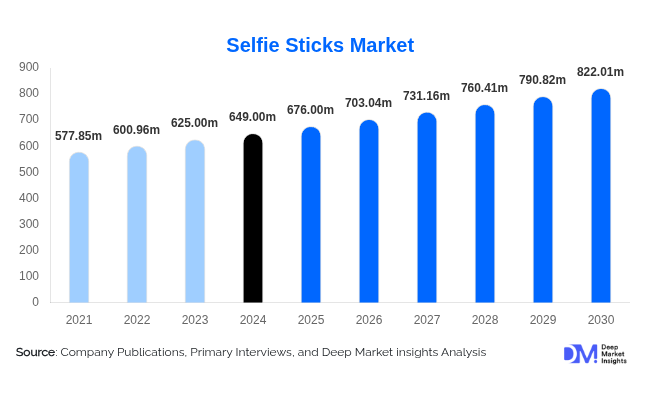Global Selfie Sticks Market to Reach USD 822 Million by 2030 at 4.0% CAGR

According to Deep Market Insights, " The global selfie sticks market, valued at USD 649.0 million in 2024, is projected to expand from USD 676.0 million in 2025 to USD 822.01 million by 2030, reflecting a compound annual growth rate (CAGR) of 4.0% during the forecast period."
Market Overview
Selfie sticks remain a key accessory for smartphone users, content creators, and travelers despite rapid advancements in smartphone camera technology. Demand is supported by the rising use of social media platforms such as TikTok, Instagram, and YouTube, where high-quality content creation requires reliable tools for framing and stability.
Bluetooth selfie sticks dominate with approximately 60% of market share, driven by wireless convenience and compatibility with smartphones and action cameras. Smartphones account for nearly 75% of total application use, while online retail channels capture 63% of overall distribution, supported by rapid e-commerce adoption.
Regional Insights
-
Asia-Pacific remains the fastest-growing region, fueled by youth-driven vlogging, social media engagement, and the presence of major e-commerce platforms. China, India, and South Korea are leading adopters.
-
North America demonstrates strong demand for premium, multifunctional models, supported by solo travel and influencer-driven content creation.
-
Europe shows steady adoption, particularly in tourism-driven countries such as Germany, France, and the U.K., where consumers prefer lightweight, premium-quality products.
-
Latin America presents emerging opportunities, especially in Brazil, Mexico, and Argentina, where demand is growing among younger consumers and domestic travelers.
-
Middle East & Africa continues to see uptake among a young demographic, boosted by tourism in markets such as the UAE, Saudi Arabia, and South Africa.
Key Growth Drivers
-
Compact and lightweight designs: Rising consumer preference for portability is driving demand for foldable, telescopic, and auto-deploying models that can be stored easily without compromising stability.
-
Tourism growth: Post-pandemic travel resurgence has strengthened the need for lightweight accessories that support solo and group photography.
-
Social media content creation: Influencers, vloggers, and casual users require reliable tools for group selfies, dynamic videos, and creative content.
-
Technology integration: Bluetooth connectivity, remote shutter controls, built-in lighting, and tripod features are enhancing convenience and user experience.
Market Restraints
-
Technological redundancy: Advancements in smartphone cameras, including gesture capture and AI stabilization, may reduce reliance on selfie sticks among casual users.
-
Usage restrictions: Bans on selfie sticks in public spaces such as stadiums, museums, and theme parks, particularly in the U.S. and Europe, limit product utility for tourists.
Opportunities
-
Customization and personalization: Brands are introducing customized models with engravings, logos, and influencer collaborations to attract Gen Z and millennial buyers.
-
Eco-friendly designs: Manufacturers are experimenting with recyclable materials such as bamboo, aluminum, and biodegradable plastics, targeting environmentally conscious consumers.
Product Insights
-
By Product Type: Bluetooth selfie sticks remain dominant due to ease of use and multifunctional features. Wired and remote-triggered models cater to niche, cost-sensitive users.
-
By Application: Smartphones account for three-quarters of demand, while cameras form a smaller but steady application segment.
-
By Distribution Channel: Online sales, led by Amazon, Flipkart, Alibaba, and MercadoLibre, continue to outperform offline channels due to selection range, convenience, and reviews.
Competitive Landscape
Market leaders are focused on integrating advanced features such as 360-degree rotation, anti-shake stabilizers, waterproofing, and foldable tripods. Leading companies include:
-
Xiaomi – Known for affordable, multifunctional designs such as the Stand Style Selfie Stick Mini and Zoom Stand Selfie Stick 2.
-
Momax – Introduced the SELFIE STABLE3 KM16, a 3-in-1 gimbal-stabilizing selfie stick with gyro sensors.
-
Other players: Anker, Fromm Works, Fotopro, KobraTech, Kootek, Mpow, Satechi, and Thinkmodo Inc.
Recent Developments
-
January 2025: Xiaomi launched the Zoom Stand Selfie Stick 2 with an 830mm anodized aluminum extension, tripod base, and detachable Bluetooth remote with 10m range.
-
October 2024: Momax introduced the SELFIE STABLE3 KM16, combining a gimbal, tripod, and Bluetooth-enabled selfie stick.
-
August 2024: Xiaomi unveiled a 1.6-meter telescopic selfie stick with enhanced tripod stability and multifunctional Bluetooth controls.
-
May 2025: Toneof launched a compact tripod-selfie stick hybrid weighing under 1 pound with a magnetic Bluetooth remote.
Outlook
The selfie stick market is expected to see sustained demand as consumers seek portable, multifunctional accessories to complement smartphone photography. Growth opportunities lie in eco-friendly product development, customizable models, and hybrid devices integrating tripods and stabilization features.
By 2030, the market will surpass USD 822 million, with Asia-Pacific remaining the fastest-growing region and North America and Europe sustaining strong adoption of premium models.







